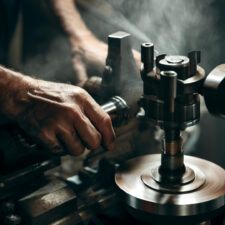Traditional machining methods have been used for centuries to manufacture a variety of different components across a wide range of industries. These methods involve using cutting tools to shape and form materials into the desired shape and size. There are a number of different traditional machining methods that are commonly used today, each with their own unique advantages and disadvantages.
Turning
Turning is a traditional machining method that is used to create round or cylindrical parts. This process involves rotating a workpiece on a lathe and using cutting tools to remove material from the outside of the workpiece. Turning is commonly used to create components such as shafts, pins, and bushings.
Milling
Milling is another traditional machining method that is used to create flat or curved surfaces. This process involves using a rotating cutting tool to remove material from a workpiece. Milling is commonly used to create components such as gears, brackets, and housings.
Drilling
Drilling is a traditional machining method that is used to create holes in a workpiece. This process involves using a rotating cutting tool to remove material from the inside of a workpiece. Drilling is commonly used to create components such as bolts, screws, and dowels.
Grinding
Grinding is a traditional machining method that is used to create smooth surfaces on a workpiece. This process involves using a rotating abrasive wheel to remove material from the surface of a workpiece. Grinding is commonly used to create components such as bearings, valve seats, and turbine blades.
Honing
Honing is a traditional machining method that is used to create a smooth surface finish on the inside of a cylindrical part. This process involves using a set of abrasive stones to remove material from the surface of the workpiece. Honing is commonly used to create components such as hydraulic cylinders and engine blocks.
Broaching
Broaching is a traditional machining method that is used to create complex shapes in a workpiece. This process involves using a special cutting tool called a broach to remove material from the inside of a workpiece. Broaching is commonly used to create components such as gears, splines, and keyways.
Advantages of Traditional Machining Methods
Traditional machining methods have a number of advantages over other manufacturing processes. For one, they are very versatile and can be used to create a wide range of different components. Additionally, they are very precise and can be used to create parts with tight tolerances. They are also relatively easy to set up and operate, making them an attractive option for small to medium-sized production runs.
Disadvantages of Traditional Machining Methods
Despite their many advantages, traditional machining methods also have some disadvantages. For one, they can be time-consuming and labor-intensive, particularly when creating complex shapes or parts with intricate geometries. Additionally, they can be expensive to set up and operate, particularly when compared to other manufacturing processes such as injection molding or 3D printing.
Conclusion
Traditional machining methods have been used for centuries to create a wide range of different components across a variety of different industries. While they have some disadvantages, they are still a very attractive option for many manufacturers due to their versatility, precision, and ease of use. Whether you are creating simple parts such as bolts and screws or more complex components such as gears and splines, traditional machining methods can help you achieve the results you need.


